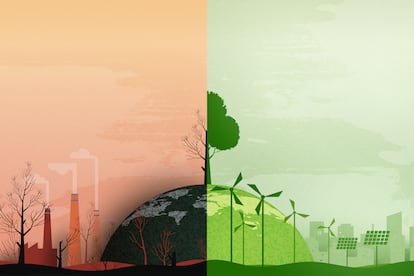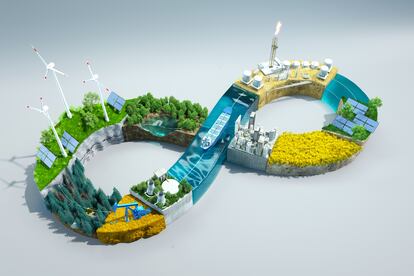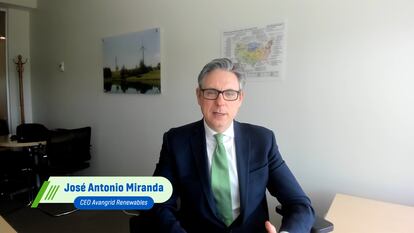Renewable energies are a beacon of hope for climate balance
With the start of the annual hurricane season upon us, meteorologists are saying they are more unpredictable this year because of the simultaneous presence of El Niño and elevated temperatures in the Atlantic. Climate change, which is sped up by human activities like the combustion of oil, gas and coal, causes higher ocean temperatures.
Satisfying the need for energy is an unavoidable topic in the conversation about climate change, yet there is hope for a better future. Progress on renewable sources offers a way to stop or reduce the most worrisome temperature increases and still cover energy needs.

“We have a responsibility to lead the way in the transformation to a clean, renewable and sustainable energy future to combat the climate crisis while transitioning our workforce to the growing clean energy jobs of the future.”
Pedro Azagra
“The science is clear — to avoid the worst impacts of climate change, emissions need to be cut almost in half by 2030 and reach net zero by 2050,” said the United Nations (UN). To achieve these objectives, the UN says the world must reduce its dependence on fossil fuels, which still account for 80% of global energy production.
One company looking to change this reliance on fossil fuels is Iberdrola, a global energy leader that has been committed to the transition to clean energy and fighting climate change for more than 20 years. The Group is led by its Executive Chairman Ignacio Galán, who recently became the augural recipient of The Foreign Policy Association’s ESG Leadership Award for his clean energy commitment and vision. Today, Iberdrola has more than 40,000 MW of renewable capacity installed worldwide via its Group, which includes Avangrid in the U.S.
Pedro Azagra, CEO of Avangrid, a subsidiary of Iberdrola, states that we have the technology and the vision to provide all the electricity we need for our daily lives”without polluting the planet and without producing the greenhouse effect that affects our climate. “We have a responsibility to lead the way in the transformation to a clean, renewable and sustainable energy future to combat the climate crisis while transitioning our workforce to the growing clean energy jobs of the future.”
NET ZERO
As a leader in sustainable energy and the third largest wind operator in the U.S., Avangrid owns and operates more than 8 GW of wind and solar installed capacity across the country and with Vineyard Wind 1, the company is developing the first large scale offshore commercial wind farm in the nation. CEO Azagra stresses that while its very important to tell people we can have more electricity, “we also have to make sure it’s produced in a responsible way that limits the impacts to our communities and doesn’t harm our environment and marine life for generations to come.”
The March 2023 report of the UN’s Intergovernmental Panel on Climate Change (IPCC) determined that these technologies and electricity generation sources must be implemented without delay to halt the intensifying and possibly irreversible destruction that is taking place.
An existential threat
From Maine, Laney Brown said intense smoke from Canada’s wildfires this spring dimmed the sun and carried pollutants all the way to New York. Brown, Avangrid’s vice president of sustainability, believes climate change is an existential threat and says that FEMA, the U.S. agency responsible for responding to storms and other natural disasters, “now has to deal with events that cost billions of dollars every single year instead of every five years.”
Brown thinks sustainability means using natural resources in a life-sustaining manner. Not only regarding the sources but also the materials used in this sector, since indispensable minerals must be extracted to make solar and wind power machinery and storage batteries. However, according to the American Council on Renewable Energy (ACORE), the life-cycle emissions of renewable energy technologies are substantially lower than fossil fuel alternatives, even with carbon capture. Brown also points to turbine and battery recycling programs. “There is a really big secondary market [for batteries], which is a perfect example of a circular economy.” Sustainability is also economically sound, says Brown. “Think about flooding, wildfires… and all the insecurity around energy — this has a tremendous cost.”
José Zayas, ACORE’s executive vice president of policy and programs, is adamant about energy security. “Think about the war in Ukraine and how much it disrupted natural gas [supply], causing an unexpected increase in consumer prices. Renewables are essentially free and always belong to you, so you have energy independence and the security of an inexhaustible supply.”
The United States “is blessed with many renewable resources,” said Zayas, explaining that the Inflation Reduction Act (IRA) of August 2022 (which includes $369 billion in spending and tax credits) and other laws “have highlighted the importance of renewable energy and raised awareness about the opportunity offered by a sector that currently generates 23% of the country’s energy.”
Renewables exceed coal generated electricity
In 2022, according to the U.S. Energy Information Administration, electricity generation from all renewable sources (wind, solar, water, biomass and geothermal) exceeded coal-generated electricity. It also surpassed nuclear in 2021 and again in 2022. Natural gas is still the largest source of electricity (39%) in the United States.
Wind and solar have been the driving force of the growth of this clean sector. Official forecasts expect renewable energy capacity to expand 380% from 2022 to 2050, while coal and natural gas generation capacity are projected to climb 11% during the same period. These projections are based on two fundamental aspects of renewable energy — cost and reliability.

According to Avangrid, technological advancements in both wind and solar have been very rapid. Regarding wind energy, the company says it’s not only the cleanest but also the most cost competitive and ocean-based facilities will eventually bring the costs down further.
José Zayas explains that consumer costs vary because each U.S. market manages its electricity system differently, but “the reason more and more renewable capacity is being installed is because it’s cost competitive. In some places, this translates into maintaining prices at current levels, and other places are seeing lower prices. We are also seeing the creation of other opportunities.” By 2021, the renewable energy sector had created over 539,000 jobs, and more job creation is expected from the IRA stimulus measures and incentives.
The test of resiliency
Avangrid explains that technical progress has made this energy source dependable, and recent storms have proven its resilience compared to other energy sources. Fossil fuel systems have been vulnerable to natural disasters. In February 2021, the Uri winter storm in Texas caused a power distribution failure, and a large majority of the problems started in natural gas and coal plants. Winter storm Elliot in December 2022 caused widespread power outages along the North American Atlantic seaboard, 91% of which were in fossil fuel plants.
Azagra has acknowledged repeatedly that renewables are an intermittent source of power — sometimes it’s cloudy and sometimes winds are calm and battery storage systems will help with this and offer more stable production. Zayas adds that greater geographical diversity and better interconnections should ensure the reliability of renewable energy systems.

Avangrid is well-positioned to guarantee a reliable supply because the company has worked on all sides of the industry for the last 20 years — production, transmission and distribution and foresaw that transmission would be an important part of the renewables revolution. ACORE agrees that expanding renewable energy transmission will be important in ensuring stable production and supply because, when the sun is not shining here, the wind is blowing over there.
The advancement of technology, the reduction of costs, the need to protect the environment, and the governmental push are all factors that point to a bright future for renewable energy. The Biden administration said it and Azagra agrees. “While we still expect other energy sources 20 years from now, our innovation, experience and the capacity to build large scale projects will ensure that power generation sources are primarily renewable. Again — we have to remember our responsibility to our next generation and leaving a better world for them than we found it.”


